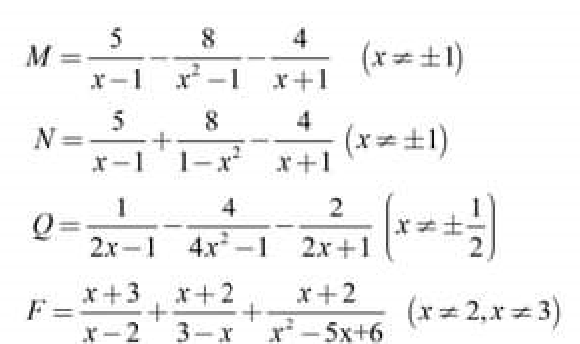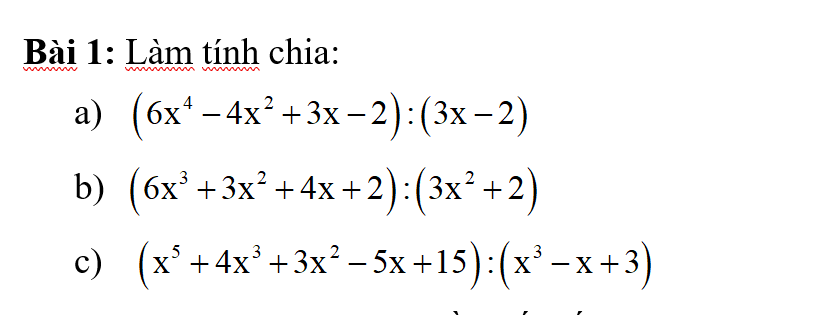Hãy nhập câu hỏi của bạn vào đây, nếu là tài khoản VIP, bạn sẽ được ưu tiên trả lời.

ĐKXĐ: \(x\notin\left\{0;-9\right\}\)
Ta có: \(\dfrac{1}{x+9}-\dfrac{1}{x}=\dfrac{1}{5}+\dfrac{1}{4}\)
\(\Leftrightarrow\dfrac{20x}{20x\left(x+9\right)}-\dfrac{20\left(x+9\right)}{20x\left(x+9\right)}=\dfrac{4x\left(x+9\right)+5x\left(x+9\right)}{20x\left(x+9\right)}\)
Suy ra: \(4x^2+36x+5x^2+45x=20x-20x-180\)
\(\Leftrightarrow9x^2+81x+180=0\)
\(\Leftrightarrow x^2+9x+20=0\)
\(\Leftrightarrow x^2+4x+5x+20=0\)
\(\Leftrightarrow x\left(x+4\right)+5\left(x+4\right)=0\)
\(\Leftrightarrow\left(x+4\right)\left(x+5\right)=0\)
\(\Leftrightarrow\left[{}\begin{matrix}x+4=0\\x+5=0\end{matrix}\right.\Leftrightarrow\left[{}\begin{matrix}x=-4\left(nhận\right)\\x=-5\left(nhận\right)\end{matrix}\right.\)
Vậy: S={-4;-5}

Hướng làm:
Thấy cả tử mẫu cộng lại đều bằng 2021 → Cộng thêm 1 rồi quy đồng với mỗi phân thức
\(\dfrac{x+2}{2019}+1+\dfrac{x+3}{2018}+1=\dfrac{x+4}{2017}+1+\dfrac{x}{2021}+1\\ \Leftrightarrow\dfrac{x+2021}{2019}+\dfrac{x+2021}{2018}-\dfrac{x+2021}{2017}-\dfrac{x+2021}{2021}=0\\ \Leftrightarrow\left(x+2021\right)\left(\dfrac{1}{2019}+\dfrac{1}{2018}-\dfrac{1}{2017}-\dfrac{1}{2021}\right)=0\\ \Leftrightarrow x+2021=0\Leftrightarrow x=-2021\)
\(< =>\dfrac{x+2}{2019}+1+\dfrac{x+3}{2018}+1=\dfrac{x+4}{2017}+1+\dfrac{x}{2021}+1\)
\(< =>\dfrac{x+2+2019}{2019}+\dfrac{x+3+2018}{2018}=\dfrac{x+4+2017}{2017}+\dfrac{x+2021}{2021}\)
\(< =>\dfrac{x+2021}{2019}+\dfrac{x+2021}{2018}-\dfrac{x+2021}{2017}-\dfrac{x+2021}{2021}=0\)
\(< =>\left(x+2021\right)\left(\dfrac{1}{2019}+\dfrac{1}{2018}-\dfrac{1}{2017}-\dfrac{1}{2021}=\right)=0\)
\(< =>x+2021=0< =>x=-2021\)
Vậy....

\(\frac{x+2}{2019}+\frac{x+3}{2018}=\frac{x+4}{2017}+\frac{x}{2021}\)
\(\Leftrightarrow\frac{x+2}{2019}+1+\frac{x+3}{2018}+1=\frac{x+4}{2017}+1+\frac{x}{2021}+1\)
\(\Leftrightarrow\frac{x+2021}{2019}+\frac{x+2021}{2018}=\frac{x+2021}{2017}+\frac{x+2021}{2021}\)
\(\Leftrightarrow x+2021=0\)
\(\Leftrightarrow x=-2021\)

a: \(M=\dfrac{5x+5-8-4x+4}{\left(x-1\right)\left(x+1\right)}=\dfrac{x+1}{\left(x-1\right)\left(x+1\right)}=\dfrac{1}{x-1}\)
b: \(N=\dfrac{5x+5-8-4x+4}{\left(x-1\right)\left(x+1\right)}=\dfrac{x+1}{\left(x-1\right)\left(x+1\right)}=\dfrac{1}{x-1}\)
1. \(M=\dfrac{5}{x-1}-\dfrac{8}{x^2-1}-\dfrac{4}{x+1}\left(x\ne\pm1\right).\)
\(M=\dfrac{5\left(x+1\right)-8-4\left(x-1\right)}{\left(x-1\right)\left(x+1\right)}\)\(M=\dfrac{5x+5-8-4x+4}{\left(x-1\right)\left(x+1\right)}=\dfrac{x+1}{\left(x-1\right)\left(x+1\right)}\)
\(M=\dfrac{1}{x-1}.\)
2. \(N=\dfrac{5}{x-1}+\dfrac{8}{1-x^2}-\dfrac{4}{x+1}\left(x\ne\pm1\right).\)
\(N=\dfrac{5\left(x+1\right)-8-4\left(x-1\right)}{\left(x-1\right)\left(x+1\right)}=\dfrac{5x+5-8-4x+4}{\left(x-1\right)\left(x+1\right)}\)
\(N=\dfrac{x+1}{\left(x-1\right)\left(x+1\right)}=\dfrac{1}{x-1}.\)
3. \(Q=\dfrac{1}{2x-1}-\dfrac{4}{4x^2-1}-\dfrac{2}{2x+1}\left(x\ne\pm\dfrac{1}{2}\right).\)
\(Q=\dfrac{2x+1-4-2\left(2x-1\right)}{\left(2x-1\right)\left(2x+1\right)}=\dfrac{2x-3-4x+2}{\left(2x-1\right)\left(2x+1\right)}\)
\(Q=\dfrac{-2x-1}{\left(2x-1\right)\left(2x+1\right)}=\dfrac{-1}{2x-1}.\)
4. \(F=\dfrac{x+3}{x-2}+\dfrac{x+2}{3-x}+\dfrac{x+2}{x^2-5x+6}\left(x\ne2,x\ne3\right).\)
\(F=\dfrac{x+3}{x-2}-\dfrac{x+2}{x-3}+\dfrac{x+2}{\left(x-3\right)\left(x-2\right)}\)
\(F=\dfrac{\left(x+3\right)\left(x-3\right)-\left(x+2\right)\left(x-2\right)+x+2}{\left(x-2\right)\left(x-3\right)}\)
\(F=\dfrac{x^2-9-x^2+4+x+2}{\left(x-2\right)\left(x-3\right)}=\dfrac{x-3}{\left(x-2\right)\left(x-3\right)}\)
\(F=\dfrac{1}{x-2}.\)



đổi x= 38/5 ; y = 12/5
B= x(x+y) -7(x+y) = (x+y)(x-7)
B= (38/5 + 12/5)( 38/5-7)= 10.3/5 = 6
mới mở máy thấy làm liền đó

\(a,=x^2+x+4x+4=\left(x+1\right)\left(x+4\right)\\ b,=x^2+2x-3x-6=\left(x-3\right)\left(x+2\right)\\ c,=x^2-2x-3x+6=\left(x-2\right)\left(x-3\right)\\ d,=3\left(x^2-2x+5x-10\right)=3\left(x-2\right)\left(x+5\right)\\ e,=-3x^2+6x-x+2=\left(x-2\right)\left(1-3x\right)\\ f,=x^2-x-6x+6=\left(x-1\right)\left(x-6\right)\\ h,=4\left(x^2-3x-6x+18\right)=4\left(x-3\right)\left(x-6\right)\\ i,=3\left(3x^2-3x-8x+5\right)=3\left(x-1\right)\left(3x-8\right)\\ k,=-\left(2x^2+x+4x+2\right)=-\left(2x+1\right)\left(x+2\right)\\ l,=x^2-2xy-5xy+10y^2=\left(x-2y\right)\left(x-5y\right)\\ m,=x^2-xy-2xy+2y^2=\left(x-y\right)\left(x-2y\right)\\ n,=x^2+xy-3xy-3y^2=\left(x+y\right)\left(x-3y\right)\)

Bài 7:
a: a>b
nên -2a<-2b
=>-2a-6<-2b-6<-2b
b: a>b
nên 3a>3b
=>3a-9>3b-9
=>3(a-3)>3(b-3)


 Giúp e bài 2 thôi ạ bài 1 e làm r ạ! Mong mn giúp e, e cần gấp ạ!
Giúp e bài 2 thôi ạ bài 1 e làm r ạ! Mong mn giúp e, e cần gấp ạ!

\(P=\dfrac{x^3+8y^3}{4^3+4^3}=\dfrac{\left(x+2y\right)^3-3\cdot x\cdot2y\cdot\left(x+2y\right)}{128}\)
\(=\dfrac{\left(-8\right)^3-6\cdot\left(-6\right)\cdot\left(-8\right)}{128}=\dfrac{128-6\cdot48}{128}=-\dfrac{5}{4}\)